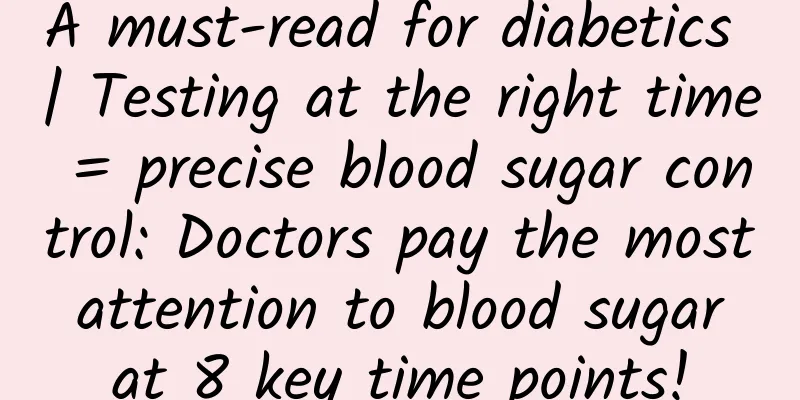A must-read for diabetics | Testing at the right time = precise blood sugar control: Doctors pay the most attention to blood sugar at 8 key time points!

|
Many diabetics know the importance of monitoring blood sugar at home. But I can't figure out which time point to measure Blood sugar data is not up to standard, and it needs to be retested during follow-up visits, which wastes a lot of time In fact, blood sugar monitoring is divided into multiple time points such as before meals, after meals, before bedtime, and at night Different situations correspond to different time points The following details the applicable scenarios and groups at each time point 1. Before breakfast (commonly known as fasting) • Those with high blood sugar levels • Those at risk of hypoglycemia •Those who use basal insulin therapy (such as glargine, detemir insulin, etc.) • Patients who use premixed insulin (such as 30R, 70/30, etc.) 2. Before lunch • Those receiving short-term intensive insulin therapy (such as basal insulin before three meals, 3 doses of premixed insulin, etc.) 3. Before dinner • Patients taking premixed insulin 4. 1 hour after meal • Hyperglycemia during pregnancy 5. 2 hours after meal •Fasting blood sugar has been well controlled, but glycosylated hemoglobin is still not up to standard • Those who need to understand the effects of diet and exercise on blood sugar 6. Before bed • Elderly patients with diabetes (≥60 years old) • Patients who are currently taking medications that increase the risk of hypoglycemia (e.g., glinides, sulfonylureas) • People who inject insulin (especially before dinner) 7. Nighttime (2-3 am) • Suspected of nocturnal hypoglycemia • Those whose fasting blood sugar is still high even though they have almost reached the target with insulin therapy 8. Special circumstances (immediate blood sugar measurement required) • If you experience symptoms of hypoglycemia (such as palpitations, anxiety, sweating, dizziness, tremors, hunger, changes in consciousness, cognitive impairment, convulsions, and coma) • Before and after strenuous exercise •After drinking (especially drinking on an empty stomach, which can easily cause hypoglycemia) • When you do not eat on time • Before driving a car for a long distance (or operating other dangerous equipment) • When acute infection occurs (such as pneumonia, vomiting, diarrhea, etc.) Special reminder from doctors 1. The key to accurate blood sugar monitoring lies in personalization, and different situations correspond to different monitoring time points! 2. Follow the plan prepared by the doctor and avoid adjusting the monitoring frequency or missing key nodes on your own! 3. When monitoring results are abnormal or changes occur in your life, be sure to consult a doctor to adjust your plan! 4. Scientific monitoring and cooperation between doctors and patients are the double insurance for achieving blood sugar control standards! Note: The content of this article is based on the "Guidelines for the Prevention and Treatment of Diabetes in China (2024 Edition)" and other public medical literature. It is only used for health education and cannot replace diagnosis and treatment! |
Recommend
What to do if you have a severe cold during breastfeeding
Colds are a very common disease in life, and we a...
How to describe the feeling of menstrual cramps
How should I describe the feeling of period cramp...
How to choose chrysanthemum? Why can't we eat too much chrysanthemum?
The dietary fiber rich in chrysanthemum can promo...
Don't take menstrual back pain and abdominal pain lightly. Beware of these gynecological diseases.
Because of their special physiological periods, i...
How to treat milky white leucorrhea with fishy smell
Leucorrhea is white and has a fishy smell. Natura...
Why do train tickets have standby tickets now? Can standby train tickets be issued?
The standby function for train tickets is still g...
Symptoms of early pregnancy: bitter mouth
Women in the early stages of pregnancy will exper...
Gynecological speculum examination
Gynecological speculum examination is actually a ...
When will the National Day free highways start? What will the temperature be like on National Day?
National Day is an important statutory holiday in...
Darkening around the nipple
The area around women's nipples becomes dark,...
It is the best health food in summer! It is not watermelon or grapes, and eating more can prevent cancer!
Author: Fluent Although today's showers have ...
Ovulation test paper early pregnancy white board
Generally speaking, it is not recommended to use ...
What are the items in male function examination?
When people reach middle age and old age, in addi...
Can I eat passion fruit during my period?
Many female friends do not have any problems at o...
GSMA: Bridging the digital divide in Central Asia and the South Caucasus
The GSMA has released its latest report, “Bridgin...









